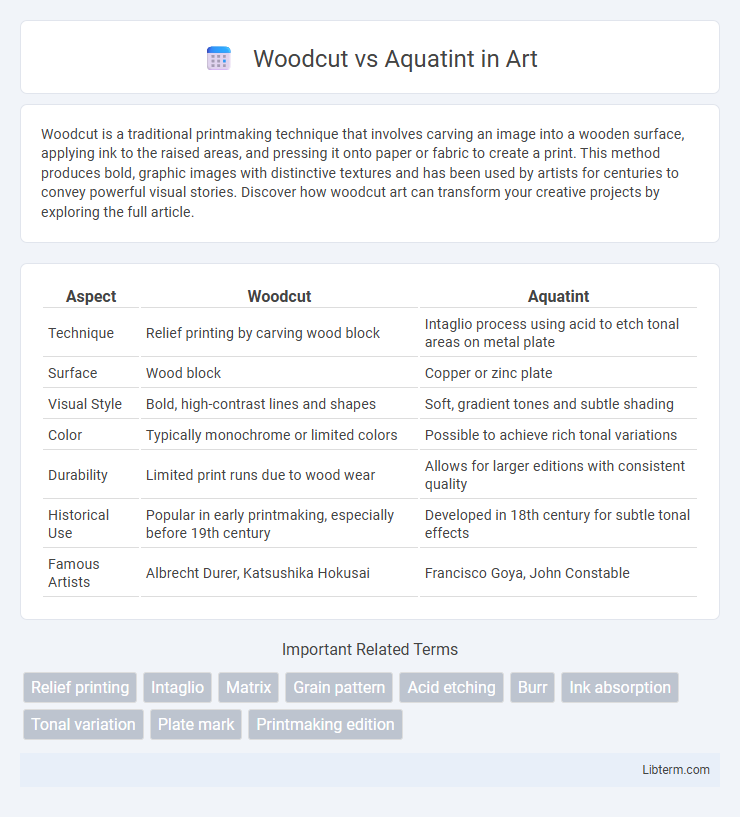Woodcut is a traditional printmaking technique that involves carving an image into a wooden surface, applying ink to the raised areas, and pressing it onto paper or fabric to create a print. This method produces bold, graphic images with distinctive textures and has been used by artists for centuries to convey powerful visual stories. Discover how woodcut art can transform your creative projects by exploring the full article.
Table of Comparison
| Aspect | Woodcut | Aquatint |
|---|---|---|
| Technique | Relief printing by carving wood block | Intaglio process using acid to etch tonal areas on metal plate |
| Surface | Wood block | Copper or zinc plate |
| Visual Style | Bold, high-contrast lines and shapes | Soft, gradient tones and subtle shading |
| Color | Typically monochrome or limited colors | Possible to achieve rich tonal variations |
| Durability | Limited print runs due to wood wear | Allows for larger editions with consistent quality |
| Historical Use | Popular in early printmaking, especially before 19th century | Developed in 18th century for subtle tonal effects |
| Famous Artists | Albrecht Durer, Katsushika Hokusai | Francisco Goya, John Constable |
Introduction to Printmaking Techniques
Woodcut and aquatint represent two distinct printmaking techniques that create diverse visual effects through different processes. Woodcut involves carving an image into a wooden block, producing bold lines and high-contrast imagery ideal for graphic storytelling. Aquatint, a variation of etching, uses powdered resin to achieve tonal gradations and subtle shading, allowing for painterly textures and nuanced detail in prints.
What is Woodcut?
Woodcut is a relief printing technique where artists carve an image into the surface of a wooden block, leaving raised areas to receive ink and transfer the design onto paper. This method emphasizes bold lines and textures, making it ideal for producing striking, high-contrast prints. Woodcuts originated in East Asia and became prominent in Europe during the early Renaissance, influencing printmaking traditions worldwide.
What is Aquatint?
Aquatint is an intaglio printmaking technique that creates tonal effects through the application of acid to a metal plate covered with a porous resin ground. Unlike woodcut, which relies on carving raised surfaces to produce images, aquatint allows artists to achieve subtle gradients and rich textures resembling watercolor washes. This method is prized for its ability to reproduce nuanced shades and intricate details in fine art prints.
Historical Background: Woodcut vs Aquatint
Woodcut, originating in ancient China around the 9th century, became a dominant printmaking technique in Europe by the 15th century, characterized by carving images into wooden blocks for relief printing. Aquatint emerged in the 18th century as a variant of etching, allowing artists to create tonal effects by etching microscopic particles onto metal plates, advancing the precision and variation in print textures. Both methods significantly shaped print art history, with woodcut emphasizing bold lines and aquatint offering nuanced shading.
Tools and Materials: Woodcut vs Aquatint
Woodcut relies on tools such as gouges and knives to carve directly into a wooden block, primarily using hardwood like cherry or maple for durability and fine detail. Aquatint employs a metal etching plate, typically copper or zinc, coated with a powdered resin that is selectively etched with acid to create tonal effects, requiring tools like acid baths, rosin dusters, and etching needles. The distinctive materials and methods in woodcut and aquatint influence the texture, line quality, and shading possibilities inherent to each printmaking technique.
Artistic Processes Compared
Woodcut involves carving an image into a wooden block, where the raised areas are inked and pressed onto paper, producing bold, high-contrast prints with distinct lines and textures. Aquatint, a variant of etching, uses resin dust applied to a metal plate to create tonal gradients, allowing artists to achieve subtle shading and soft transitions between light and dark. Compared to woodcut's direct relief technique, aquatint's intaglio process enables more nuanced depth and atmospheric effects in printmaking.
Visual Effects and Style Differences
Woodcut prints feature bold, high-contrast lines and a textured, graphic quality resulting from carving into wood blocks, emphasizing sharp edges and dramatic shadows. Aquatint creates subtle tonal variations and smooth gradients by etching acid-resistant resin particles onto metal plates, producing a softer, more painterly effect with delicate shading. The stark, linear intensity of woodcuts contrasts with aquatint's nuanced, atmospheric depth, making each technique distinct in visual impact and stylistic expression.
Key Artists and Notable Works
Albrecht Durer is a key figure in woodcut, renowned for works like "The Four Horsemen of the Apocalypse" that showcase intricate line work and strong contrasts. In aquatint, Francisco Goya stands out with masterpieces such as "Los Caprichos," using tonal variations to create atmospheric depth. These artists highlight the distinctive techniques and expressive possibilities inherent to woodcut and aquatint printmaking.
Advantages and Limitations
Woodcut offers strong, bold lines and a graphic quality ideal for high-contrast images, making it advantageous for creating striking, easily reproducible prints; however, it is limited by less subtle shading and detail. Aquatint excels in producing tonal variations and soft gradients, providing rich textures and depth similar to watercolor washes, but it requires more complex preparation and longer printing times. Both techniques serve distinct artistic purposes, with woodcut favoring durability and simplicity, and aquatint emphasizing nuance and subtlety.
Choosing Between Woodcut and Aquatint
Choosing between woodcut and aquatint depends on the desired visual effect and texture in printmaking; woodcut creates bold, graphic lines through carving into wood blocks, ideal for strong contrast and simplified forms, while aquatint produces tonal variation and subtle gradients by etching resin-coated metal plates, offering a painterly quality. Woodcut suits artists seeking clear, striking images with a handcrafted feel, whereas aquatint appeals to those aiming for nuanced shading and depth in monochromatic prints. Consider factors like detail complexity, texture preference, and production time when deciding the most effective technique for your artwork.
Woodcut Infographic

 libterm.com
libterm.com